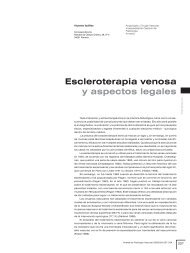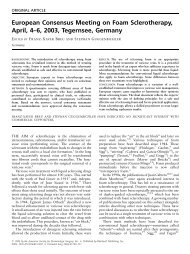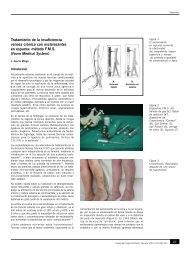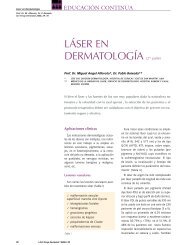The History of Sclerosing Foams
The History of Sclerosing Foams
The History of Sclerosing Foams
You also want an ePaper? Increase the reach of your titles
YUMPU automatically turns print PDFs into web optimized ePapers that Google loves.
698 WOLLMANN: THE HISTORY OF SCLEROSING FOAMS Dermatol Surg 30:5:May 2004<br />
Figure 5. <strong>The</strong> aspiration technique: <strong>The</strong> tip <strong>of</strong> the needle was placed<br />
at the liquid–air interface, thus allowing coaspiration <strong>of</strong> air and<br />
sclerosant that would generate foam in one run.<br />
introduced into the ampoule in such a way that<br />
approximately two thirds <strong>of</strong> the opening <strong>of</strong> the bevel<br />
are imbibed in the fluid (see Figure 5). When drawing<br />
back the plunger, the syringe fills with Varsyl foam<br />
under a sizzling noise, the foam remaining stable for<br />
several minutes.’’<br />
1957: Heinz Mayer and Hans Brücke: 16 First<br />
Micr<strong>of</strong>oam Device (Double-Piston Syringe)<br />
A milestone regarding the improvement and standardization<br />
<strong>of</strong> sclerosing foam was the publication by two<br />
surgeons Mayer and Brücke: they described the first<br />
device that had been developed specifically for the<br />
preparation <strong>of</strong> viscous sclerosing foams, a syringe with<br />
a double plunger (see Figure 6). (A double-plunger<br />
syringe following the principle <strong>of</strong> Mayer-Brücke was<br />
‘‘reinvented’’ several times in the following decades. A<br />
very homogenous, extremely fine microbubble foam<br />
can be produced using a simple reproduction <strong>of</strong> that<br />
syringe—unfortunately, the original is no longer<br />
available. More than 40 years ago, Mayer and Brücke<br />
worked with foams that are now suggested to be<br />
classified as ‘‘micr<strong>of</strong>oam.’’ 17 )<br />
‘‘Before the main plunger, there is a second, thin<br />
plunger with numerous holes, whose piston leads to a<br />
central bore <strong>of</strong> the main plunger and protrudes it.<br />
When the main plunger is fixed, the plunger provided<br />
with holes can rapidly be moved forward and backward<br />
and the Phlebocid (ethanolamin oleate) can be<br />
mixed with the air contained in the syringe. A finebubbled,<br />
viscous foam developsy. We have tested<br />
Figure 6. <strong>The</strong> Mayer-Brücke device: <strong>The</strong> inner plunger with numerous<br />
tiny holes can rapidly be moved forward and backward to mix<br />
sclerosant and air contained in the syringe. <strong>The</strong> outer plunger was used<br />
for injection <strong>of</strong> the viscous and fine-bubbled foam.<br />
most sclerosants <strong>of</strong> similar composition and selected<br />
Phlebocid, which provides the stiffest foam upon<br />
agitation with a homogenous distribution <strong>of</strong> air<br />
bubblesy. We consider the greatest advantage <strong>of</strong> the<br />
use <strong>of</strong> foam y to be the homogenous distribution <strong>of</strong><br />
the sclerosanty.’’ Clinically, they stated after administration<br />
<strong>of</strong> foam: ‘‘<strong>The</strong> fibrous tissue <strong>of</strong> the venous<br />
lumen is so complete that in general, recanalizationydoes<br />
not occur. We never observed recurrent<br />
varicose veins after using Phlebocid foam. We never<br />
observed complications after foam filling such as air<br />
embolisms or skin necroses.’’<br />
1962—Peter Flückiger: 18 Turbulent Flow<br />
In 1962, Flückiger described another technique for the<br />
preparation <strong>of</strong> foam: pumping <strong>of</strong> air and sclerosant<br />
forward and backward between a drug vial and the<br />
attached syringe. Later, this technique was modernized<br />
and improved by Alessandro Frullini 19,20 by adding an<br />
adapter between the syringe and the bottle seal.<br />
Furthermore, Flückiger changed some points since<br />
his first publication in 1956: he maintained leg<br />
elevation not only during sclerotherapy but also for<br />
some minutes thereafter, to allow the foam to degrade.<br />
He warned therapists to be cautious while ‘‘stroking’’<br />
the foam seal in a peripheral direction to prevent any<br />
unintended movement <strong>of</strong> foam into the deep venous<br />
system. Today, it is recommended that you wait some<br />
minutes after foam sclerotherapy <strong>of</strong> large veins before<br />
applying compression. 42<br />
1963—Peter Lunkenheimer: 21 First Use <strong>of</strong><br />
Polidocanol Foam<br />
Even before polidocanol received its first marketing<br />
authorization, a German physician had the chance to<br />
use the novel sclerosing solution for research purposes<br />
for the first time. Kreussler’s archives revealed a letter<br />
from that phlebologist, which contains a written ‘‘case<br />
report’’ about the first patient treatment: ‘‘<strong>The</strong> first<br />
patient was treated with 2 mL Aethoxysklerol s<br />
foamy.’’






